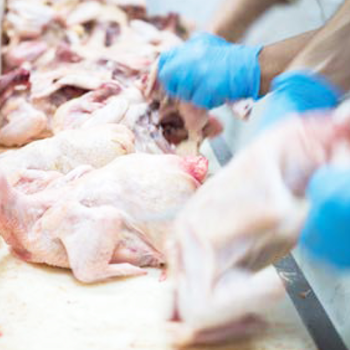DKSH ทุ่มทุนขยายและปรับปรุงศูนย์นวัตกรรมด้านอาหารและเครื่องดื่มที่ทันสมัยในประเทศไทย
กรุงเทพฯ, 19 มกราคม 2561 – กลุ่มธุรกิจผลิตภัณฑ์และวัตถุดิบอุตสาหกรรม บริษัท ดีเคเอสเอช (ประเทศไทย) จำกัด ลงทุนขยายและปรับปรุงศูนย์นวัตกรรมในประเทศไทย เพื่อตอบสนองความต้องการของธุรกิจอุตสาหกรรมและเครื่องดื่ม โดยมุ่งเน้นในด้านการพัฒนาสูตรและสนับสนุนข้อมูลเชิงเทคนิคให้กับคู่ค้าในประเทศไทย ศูนย์นวัตกรรมพื้นที่ 130 ตารางเมตร ที่ปรับปรุงใหม่นี้เปรียบเสมือนทั้งสัญลักษณ์แห่งความสำเร็จของบริษัทฯ และเป็นการตอกย้ำการให้บริการที่เป็นเลิศกับกลุ่มลูกค้า แบ่งเป็น 3 โซน ได้แก่ ห้องปฏิบัติการพัฒนาสูตรสำหรับผลิตภัณฑ์นมและเครื่องดื่ม ห้องปฏิบัติการสำหรับอาหารแปรรูปและกลุ่มธุรกิจฟู้ดเซอร์วิส และห้องปฏิบัติการผลิตภัณฑ์เบเกอรี่ โดยในแต่ละปีได้สร้างสรรค์ผลิตภัณฑ์ต้นแบบออกมาถึง 150 ผลิตภัณฑ์ กว่า 200 สูตร อาทิ เบเกอรี่ (เค้กมาม่อน มัฟฟินสูตรน้ำตาลต่ำ และครัวซองต์ปราศจากไขมันทรานส์) นมและเครื่องดื่ม (เครื่องดื่มฟังก์ชันนัล น้ำผักและผลไม้ และกรีกโยเกิร์ต) และผลิตภัณฑ์อาหารคาว (ไส้กรอกไขมันต่ำ มายองเนสปราศจากไข่ และบะหมี่กึ่งสำเร็จรูปสูตรลดเกลือ)
ทั้งนี้ ดีเคเอสเอชมีศูนย์นวัตกรรมสำหรับอาหารและเครื่องดื่มอยู่ 7 แห่ง และห้องปฏิบัติการด้านการประยุกต์ใช้อีก 14 แห่งในภูมิภาคเอเชียและยุโรป พรั่งพร้อมด้วยอุปกรณ์และเครื่องมือทันสมัย เพื่อให้บริการในด้านการพัฒนาสูตร การพัฒนาผลิตภัณฑ์ การทดสอบความคงตัวของผลิตภัณฑ์ การประเมินทางประสาทสัมผัส การทดลองผลิต ตลอดจนการฝึกอบรมเชิงเทคนิค นอกจากนี้ ผู้เชี่ยวชาญจากศูนย์นวัตกรรมจะทำงานร่วมกับลูกค้าในการให้คำปรึกษาและสนับสนุนข้อมูลที่จำเป็นสำหรับการขึ้นทะเบียนผลิตภัณฑ์อาหารอีกด้วย
Mr.Thomas Sul, DKSH’s Co-Head Business Unit Performance Materials ระบุว่า “ด้วยเครือข่ายในการจัดหาวัตถุดิบที่มีอยู่ทั่วโลกของดีเคเอสเอช ศูนย์นวัตกรรมแห่งนี้จะช่วยให้เราสามารถนำเสนอเทรนด์นวัตกรรมอาหารและเครื่องดื่มใหม่ๆ จากประเทศอื่นๆ มาสู่ประเทศไทย โดยสามารถปรับเปลี่ยนได้ตามความต้องการของท้องถิ่น ประกอบกับการสนับสนุนในด้านการพัฒนาสูตรจากดีเคเอสเอช ซึ่งจะช่วยให้ภาคธุรกิจอาหารและเครื่องดื่มของไทยสามารถพัฒนาผลิตภัณฑ์ใหม่ๆ อาทิ ผลิตภัณฑ์ที่มีประโยชน์ในเชิงสุขภาพ สูตรน้ำตาลน้อย สูตรไขมันต่ำ และสูตรลดเค็ม เป็นต้น”
สอดคล้องกับนโยบายอุตสาหกรรม 4.0 ของรัฐบาลไทย ศูนย์วิจัยนี้ยังช่วยเอื้อประโยชน์ให้ผู้ผลิตอาหารและเครื่องดื่มของไทยสามารถส่งออกสินค้าไปยังตลาดอื่นๆ คุณทรงสิน สังขเวทัย ผู้จัดการทั่วไป – อุตสาหกรรมอาหารและเครื่องดื่ม กลุ่มธุรกิจผลิตภัณฑ์และวัตถุดิบอุตสาหกรรม บริษัท ดีเคเอสเอช (ประเทศไทย) จำกัด กล่าวว่า “เราสามารถใช้ประโยชน์ร่วมกัน เนื่องจากศูนย์นวัตกรรมของเราทำงานร่วมกับศูนย์นวัตกรรมอื่นๆ ในภูมิภาคเอเชียแปซิฟิกที่ศึกษาเรื่องการปรับปรุงสูตรอย่างเชื่อมโยงและใกล้ชิด เราสามารถปรับใช้ข้อมูลการปรับปรุงสูตรจากหลายประเทศเข้ากับความต้องการของลูกค้าที่ต้องการส่งออกสินค้าอาหารและเครื่องดื่มไปยังประเทศต่างๆ ที่ต้องการ”
“จากเจ้าหน้าที่ 1,000 คนในกลุ่มธุรกิจผลิตภัณฑ์และวัตถุดิบอุตสาหกรรม เรามีเจ้าหน้าที่กว่า 50 คนที่ทำงานในศูนย์นวัตกรรมและค้นคว้าสูตรอาหารใหม่ ซึ่งคิดเป็นร้อยละ 5 ของพนักงานทั้งหมด พวกเขาร่วมระดมสมองเพื่อค้นหาความคิดใหม่ สูตรใหม่ แนวคิดใหม่ วิจัยตลาดและเก็บข้อมูลตลาด รวมทั้งการดูแลในเรื่องกฎหมายต่างๆ เพื่อให้มั่นใจว่าเราสามารถปฏิบัติตามกฎหมายใหม่ๆ ที่เกิดขึ้น” Dr.Natale Capri, DKSH’s Co-Head Business Unit Performance Materials กล่าวเสริม “เราลงทุนอย่างเต็มที่ในด้านการบริการเพื่อเพิ่มมูลค่า ข้อมูล องค์ความรู้ และเทคโนโลยีเพื่อพัฒนาสินค้าใหม่ๆ ให้กับคู่ค้าทางธุรกิจของเรา”
เพื่อช่วยให้ลูกค้าสามารถพัฒนาสูตร ดีเคเอสเอชได้นำเสนอส่วนผสมอาหารหลายรายการ ซึ่งมีการพัฒนาและปรับปรุงอยู่เสมอ “เราต้องสร้างความมั่นใจตั้งแต่ต้นว่า ส่วนผสมอาหารที่เรานำเสนอนั้นมีพร้อมเพื่อตอบโจทย์ความต้องการของลูกค้า นอกจากนี้เรายังช่วยสรรหาบริษัทผู้รับจ้างผลิต (OEM) และให้คำแนะนำในเรื่องการขึ้นทะเบียนและการกล่าวอ้าง เหล่านี้เป็นการเพิ่มมูลค่าในบริการของเราให้กับลูกค้าอีกด้วย” คุณทรงสิน กล่าว
Dr.Capri เสริมว่า “ประเทศไทยถือเป็นศูนย์กลางของภูมิภาคเอเชียตะวันออกเฉียงใต้ เรายังดูแลคู่ค้าในประเทศกัมพูชา ลาว และเมียนมา โดยในปี 2561 นี้ คาดว่าเศรษฐกิจไทยมีแนวโน้มเติบโตถึงร้อยละ 5 และเราหวังที่จะเติบโตขึ้นเช่นกันจากเศรษฐกิจที่เติบโตขึ้นในประเทศไทย”
ด้าน Mr.Sul ประเมินว่า ในปี 2561 ตลาดในประเทศไทยน่าจะมองหาสินค้าที่ลดน้ำตาล ลดเค็ม ปราศจากไขมันทรานส์ ผลิตภัณฑ์ที่ใช้ทดแทนเนื้อสัตว์สำหรับผู้ที่รับประทานทานเจหรือมังสวิรัติ ตลอดจนผลิตภัณฑ์นูทราซูติคัล “เราสามารถช่วยเหลือคู่ค้าโดยทำงานร่วมกันเพื่อมองหาเทรนด์ใหม่ๆ สรรหาผู้จำหน่ายส่วนผสมอาหารที่ใช่ และพัฒนาปรับปรุงสูตรเพื่อให้สามารถตอบโจทย์ของผู้บริโภคในประเทศไทย”
DKSH expands and upgrades to state-of-the-art food and beverage innovation center in Thailand
Bangkok, 19 January 2018 – DKSH’s Business Unit Performance Materials has made a major investment in its food and beverage business by expanding and upgrading its innovation center in Thailand. The innovation center, which is both a symbol of the company’s achievements to date and represents its commitment to providing continued operational excellence to clients, specializes in developing food and beverage formulations and provides expert technical support to its business partners in Thailand. The center has a capacity of 130 sq. m. and caters for three segments of the food and beverage industry: beverage and dairy (for formulations), processed food and food service (for savory applications) and bakery (for bakery applications). Currently, it develops over 150 prototypes and 200 formulations per year including: unique bakery products such as mamon cakes, low sugar muffins and transfat-free croissants; beverage and dairy products such as functional drinks, fruits and vegetable drinks and greek yoghurt; and savory products such as low-fat sausages, egg-free mayonnaise and low sodium instant noodles.
Joining a network of seven DKSH food and beverage innovation centers (with 14 application laboratories) in Asia and Europe, the center houses some of the industry’s most advanced development and analysis equipment. It provides a broad range of specialized services including: formulation application, product ideation and development support, stability testing, sensory evaluation, pilot trials and technical training. In addition, its specialists work closely with a dedicated regulatory team to provide consultation and support for the complex regulatory environment of the food and beverage industry in Thailand.
DKSH’s Co-Head Business Unit Performance Materials, Mr.Thomas Sul, stated that “Together with our global sourcing network, this innovation center enables us to introduce, to Thailand, the latest innovative food and beverage trends from the other markets and custom them to local needs.” This will allow Thai food and beverage businesses to develop new products that are “more healthy, low in sugar, low in fat and low in salt” thanks to our performance-enhancing formulations.
Conforming with Industry 4.0 policy implemented by the Thai government, the innovation center can support Thai food and beverage producers export their products to other markets. “We can leverage each other”, said Mr.Songsin Sungkhawaetai, DKSH’s General Manager – Food & Beverage Industry, Business Unit Performance Materials, “We work in close collaboration with our network of innovation centers in Asia Pacific, all of which produce food formulations. This allows us to introduce innovative formulations across the region to business partners that export food and beverage products”.
“There are over 1,000 specialists in DKSH Business Unit Performance Materials globally and we count more than 50 people who are based in innovation centers. This means that more than 5% of the workforce develops new ideas, new formulations and new concepts and undertakes market research and market intelligence activities. To support our innovation specialists, we have a regulatory team who ensure that we comply with all existing, new and upcoming laws and legislations”, added Dr.Natale Capri, DKSH’s Co-Head Business Unit Performance Materials. “We are investing a lot in our value-added services to ensure that our excellence in innovation, sourcing, regulatory and information allows us to develop exciting new products for our business partners.”
In order to help customers with formulations, DKSH provides a comprehensive portfolio of specialist food ingredients, which is regularly updated with new sources. “We ensure that a wide range of innovative ingredients are available to our business partners, as well helping them to find suitable OEM companies. We also provide consultation regarding FDA registration and health claims, bringing added valued to our service offerings”, said Mr.Sungkhawaetai.
Dr.Capri later added that “Thailand is the hub for Southeast Asia. Our business partners in Cambodia, Lao PDR and Myanmar also benefit from the advancements we make in Thailand and throughout the region.” and that “In 2018, we have high expectations. The Thai economy is expected to increase by 5% – this boom will provide us with some good market opportunities.”
The prediction for 2018 as viewed by Mr.Sul is that Thailand will yearn for products that offer sugar reduction, salt reduction, trans-fat free, meat replacement (for vegan and vegetarian) and nutraceutical benefits. “We work hand-in-hand with our business partners to identify trends, secure the right ingredient suppliers and produce formulations that fit to Thai tastes.”, said Mr.Sul.
www.dksh.co.th

(From left to right)
- 1. Mr.Mathias Greger, Vice President, Business Unit Performance Materials, DKSH Thailand
- 2. Dr.Natale Capri, Co-Head Business Unit Performance Materials, DKSH
- 3. Mr.Stefan P. Butz, Chief Executive Officer, DKSH
- 4. Mr.Thomas Sul, Co-Head Business Unit Performance Materials, DKSH
- 5. Mr.Ben Hopkins, Vice President, Global Food & Beverage Industry, Business Unit Performance Materials, DKSH
- 6. Mr.Douglas Humphrey, Head Country Management, DKSH Thailand









